RISING STORM - THE IMPERIAL JAPANESE NAVY AND
CHINA
1931-1941
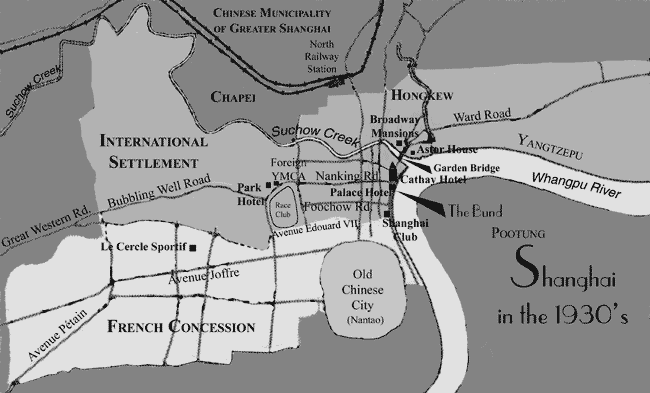 Shanghai in 1930s
Shanghai in 1930s
The Beginning of The Second Sino-Japanese War - "The Marco Polo
Bridge Incident" and the Fall of Peiping and Shanghai - 1937
© 2012-2013 Bob Hackett, Sander Kingsepp and Anthony Tully
Revision 3
1842:
At the end of the First Opium War, under the Treaty of Nanking, China opens five treaty ports to Britain (Shanghai, Ningpo [Ningbo], Foochow [Fuzhou], Amoy [Xiamen] and Canton [Guangzhou]) and cedes Hong Kong Island to Britain among other things. A British settlement is established at Shanghai, followed soon thereafter by American and French settlements. The American settlement is to the north of the British settlement and the French settlement is established to the south. In 1849, after the Chinese cede additional territory to France, a "French Concession" is established.
1863:
The Shanghai International Settlement is established after the British and American settlements formally unite. Unlike the British Crown Colony of Hong Kong, the Shanghai International Settlement remains sovereign Chinese territory. In both 1900 and 1914, the borders of the French Concession are expanded. In the 1920s, it develops into the premier residential area of Shanghai.
1918:
After the Russian Revolution, Shanghai’s population swells by the immigration of many White Russians fleeing the Communist Red Russians. After the Japanese occupy Manchuria, further immigration to Shanghai follows. At the start of the Second Sino-Japanese War, the Chinese population in the French Concession is about 500,000. Shanghai proper is now a city of nearly 4,000,000 - the sixth largest in the world.
1931:
After the Mukden Incident during which Japan invades Manchuria, Japan and China fight small, localized engagements. From 1 Jan '33 to 31 May '33, Japanese and Chinese troops fight the First Battle of Hopei. During this campaign, Japan captures the Inner Mongolian province of Rehe and annexes it to the new state of Manchukuo extending its southern frontier to the Great Wall of China. The Tanggu Truce of May '33 results in the demilitarization of Shanghai and creates a zone extending one hundred kilometers south of the Great Wall in which the Chinese army is prohibited from entering. These conflicts are called "incidents" since neither Japan nor China make a formal declaration of war. Japan wants to avoid intervention by other countries, most notably the United States and the United Kingdom, which are her primary sources of petroleum; the United States is also her largest supplier of steel. The last of these incidents is the Marco Polo Bridge Incident.
7 July 1937: The Marco Polo Bridge Incident ("First China Incident"):
Hun River, Lukuokiao, China. Imperial Japanese Army (IJA) troops on night maneuvers at the Marco Polo Bridge fire blank cartridges. Chinese troops across the river think they are under attack. They fire live rounds back, but do not cause injuries. At morning roll call, the Japanese discover a soldier missing and assume the Chinese have captured him. The Japanese demand entry to the Peiping (Beijing) suburb of Wanping to look for the soldier, but the Chinese refuse. The Japanese then shell the city. An undeclared war on China begins. [1]
9 July 1937:
The Japanese offer a ceasefire and truce, but despite the truce, numerous violations of the cease-fire continue.
11 July 1937:
The IJA and IJN agree to operational jurisdictions in the event of a full-scale war with China. The IJA takes responsibility for northern China and the IJN assumes assumes responsibility for central and southern China. At this time, the IJN's air power in-theater consists of only about 80 planes carried by carriers KAGA, RYUJO and HOSHO on station in the East China Sea.
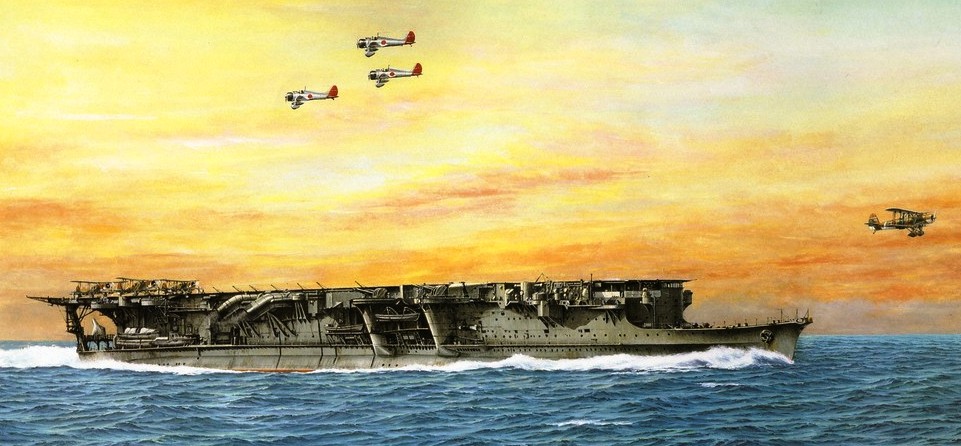 IJN RYUJO by T. Yuki
IJN RYUJO by T. Yuki
That same day, light cruiser IJN IZUMO, flagship of the 10th Squadron of Vice Admiral Hasegawa Kiyoshi’s (31) Third Fleet, arrives at Shanghai.
12 July 1937:
The Third Fleet's carrier IJN HOSHO departs Sasebo for the China coast.
14 July 1937:
Peiping. Japanese artillery shells the Wanping suburb.
16 July 1937:
After arriving off the Ma-an-shan Islands, HOSHO begins supporting land operations. Carriers KAGA and RYUJO also engage in aerial battles.
25 July 1937:
Peiping (Beijing). The Japanese attempt to force through Guanghuamen Gate to "protect Japanese nationals". That same day, Japanese planes bomb Langfang. The Japanese issue an ultimatum and demand withdrawal of all Chinese forces from the outskirts of Peiping within 24 hours. The Chinese refuse.
LtGen Kawakishi Bunsaburo's IJA 20th Division arrives and fighting resumes at Langfang, a city on the railroad between Peiping and Tientsin (Tianjin).
Shanghai. Three Nakajima Type 90 bi-plane fighters from HOSHO engage two Chinese Air Force (CAF) Martin B-10 heavy bombers and shoot one down.
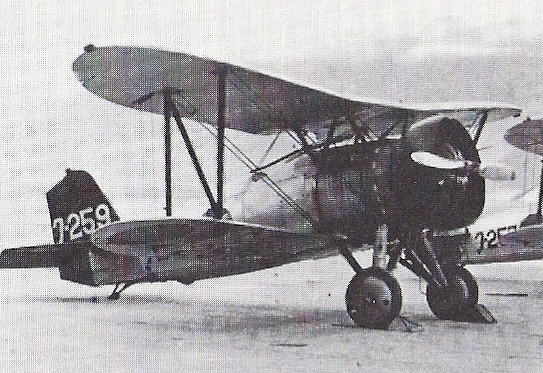
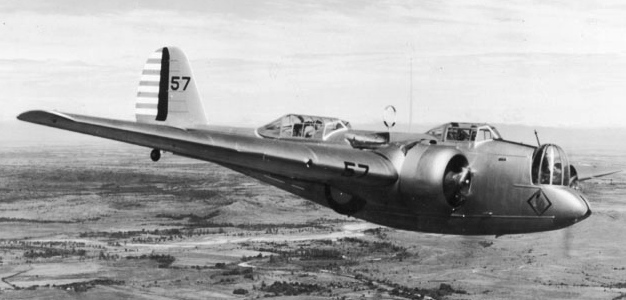 IJN Nakajima Type 90 and a Martin B-10B (in U.S. markings)
IJN Nakajima Type 90 and a Martin B-10B (in U.S. markings)
28 July 1937:
Backed by close air support, the IJA 20th Division and three independent brigades launch an offensive against Peiping. The Chinese suffer heavy casualties, but push back the Japanese in the Langfang area and recover the railway station.
29 July 1937: The Fall of Peiping:
The Japanese capture the ancient Imperial Chinese capital of Peiping.
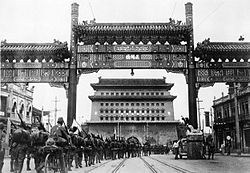 Japanese troops enter Peiping.
Japanese troops enter Peiping.
At dawn that same day, the IJA 5th Division and IJN forces separately attack Tientsin and the port at Tanggu, defended by units of Chinese 38th Division and volunteers. A Chinese brigade defends the Taku Forts and attacks a nearby Japanese airfield, destroying many planes.
30 July 1937:
Hai River. The world's first specially designed landing ship IJA SHINSHU MARU lands IJA troops at Tientsin (Tianjin) making the Chinese position untenable. That night they withdraw south of Tientsin (abandoning the city and Taku Forts to the Japanese. Tientsin is not entirely occupied, as the Japanese, for the most part, respect its foreign concessions. [2]
August 1937:
Chiang Kai Shek's Chinese Nationalist Government sends light cruiser PING HAI and sister NING HAI, old cruiser YING JUI and a gunboat down the Yangtze River to Koin (Chiang Yin) to help defend Nanking, the Nationalist's capital city.
2 August 1937:
Lushun (Port Arthur), Manchuria. Submarine tender IJN CHOGEI receives news that the Japanese bridgehead in Shanghai is under heavy attack. CHOGEI embarks soldiers of the No. 1 Special Naval Landing Force (SNLF).
3 August 1937:
Nanking (Nanjing). As Japanese forces approach, gunboats USS LUZON (PR-4)(later IJN KARATSU) and USS TUTUILA (PR-4) evacuate American Ambassador Nelson T. Johnson and his staff to Chungking.
9 August 1937:
Seaplane tender/oiler IJN KAMOI departs Sasebo with destroyer ASANAGI to photo-recon Chinese military bases at Hangzhou Bay, Shanghai.
10 August 1937:
KAMOI and ASANAGI arrive at Ma'an anchorage, Zhoushan (Shoushan) Islands, near Shanghai. The next day, they complete the mission in the afternoon and retire.
10 August 1937:
KAGA departs Terajima Strait (off Sasebo), escorting a troop convoy.
12 August 1937:
CarDiv 1's HOSHO and RYUJO depart Sasebo, probably together.
13 August 1937: The Second Battle of Shanghai:
Shanghai. The Chinese undertake an all-out attack on Japanese positions. At 0900, more than 10,000 Japanese troops enter the suburbs. Fighting begins in the Zhabei, Wusong and Jiangwan districts. IJA SHINSHU MARU participates in the battle. The Japanese put ashore SNLF reinforcements. At 1600, warships of Vice Admiral (later Admiral) Hasegawa Kiyoshi’s (31)(former CO of NAGATO) 3rd Fleet in the Huangpu (Whangpu) and Yangtze Rivers begin bombarding Chinese shore positions.
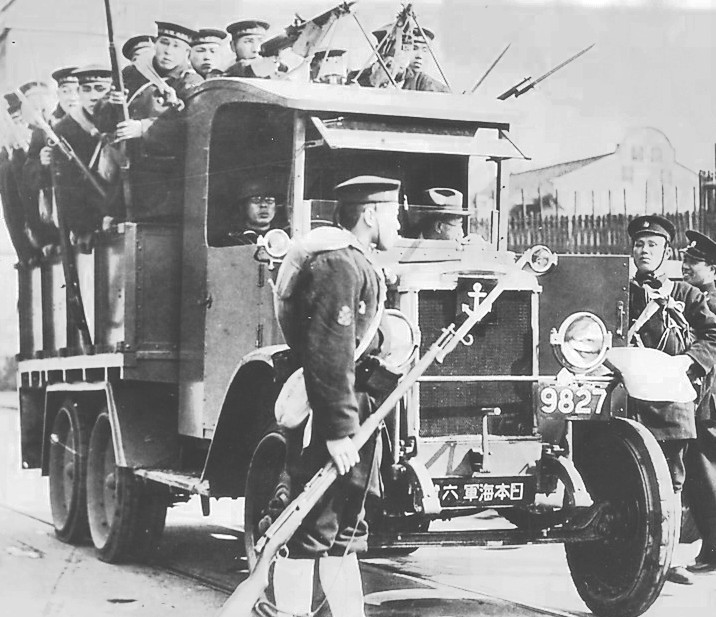 (IJN SNLF troops in Shanghai, Aug '37)
(IJN SNLF troops in Shanghai, Aug '37)
In view of the increasing danger, Japanese residents in Shanghai decide to repatriate women and children. About 20,000 of the total 30,000 residents are successively returned home about 19 August.
14 August 1937: "Bloody Saturday":
Shanghai.
Flagship USS AUGUSTA (CA-31), carrying Admiral Harry E. Yarnell (USNA 1897)(former CO of SARATOGA, CV-3), CINC, United States Asiatic Fleet, arrives from Tsingtao after battling a typhoon and anchors in the Whangpu River. That same day, the Chinese Air Force (CAF) under their acting operational CO, retired Captain (later LtGen) Claire L. Chennault, launches aircraft to attack IJN flagship IZUMO and the Japanese fleet. The CAF also mistakenly bombs British cruiser HMS CUMBERLAND, but their bombs fall wide. Two bombs also fall close alongside AUGUSTA, but no one is killed.
The Dollar Line steam ship SS PRESIDENT HOOVER, at anchor in the Yangtze, is also bombed by the CAF that mistake HOOVER for ASAMA MARU, a Nippon Yusen Kaisha (NYK) passenger/cargo ship of similar appearance being used as a troop transport. One of HOOVER's crewmen is killed and six wounded together with two passengers.
 (Dollar Line steam ship SS PRESIDENT HOOVER)
(Dollar Line steam ship SS PRESIDENT HOOVER)
Finally, the CAF accidentally drops bombs into Shanghai city hitting the Palace Hotel and the Great World Amusement Palace a mile away and places in between. More than 1,700 civilians are killed and 1,800 wounded.
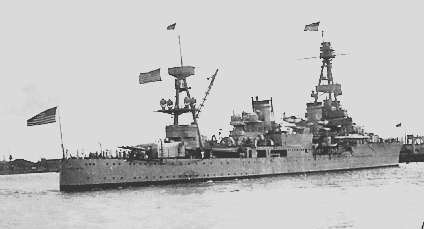 (United States Asiatic Fleet's flagship USS AUGUSTA (CA-31) at Shanghai, 1937)
(United States Asiatic Fleet's flagship USS AUGUSTA (CA-31) at Shanghai, 1937)
A Type 90 scout floatplane from IZUMO attacks the CAF formations and shoots down a fighter. A Type 95 floatplane from light cruiser SENDAI shoots down another Chinese plane.
Minelayer IJN YAEYAMA and the 11th Gunboat Division put ashore SNLF reinforcements. The CAF attacks the SNLF positions. In retaliation, the IJN sanctions long-range strikes from airfields near Taipei, Formosa (Taiwan).
Matsuyama Airfield, Taipei. That day and the next two days, the Kanoya Naval Air Group (NAG) launches three strikes at airfields near Hangchow by a total of 29 Mitsubishi G3M1 "Nell" bombers, three of which are lost to CAF "Hawk III " fighters and three to AAA fire.
Chejudo (Quelpart) Island, Korea. The Kisarazu NAG launches two attacks, losing five of 29 bombers.
15 August 1937:
KAGA arrives off Shanghai with 12 Mitsubishi B2M2 Type 89 attack aircraft, 13 Yokusuka B3YI Type 94 attack aircraft, 14 Aichi D1A1 Type 94 dive-bombers and 16 Nakajima A2N3 Type 90 bi-plane fighters.
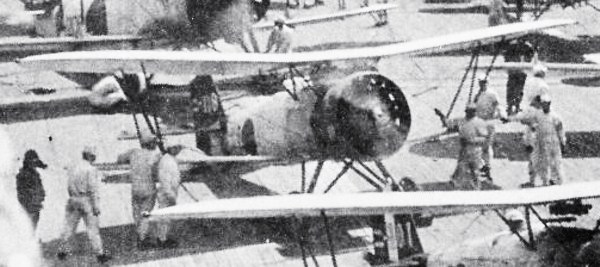 (A2N3 Type 90 fighter aboard KAGA).
(A2N3 Type 90 fighter aboard KAGA).
At 0530, KAGA launches 12 B2M2 torpedo-bombers against Hangchow's (Hangchou) air bases, but they are intercepted by 21 of the CAF 4th Pursuit Group's "Hawk III" bi-plane fighters. Six B2M2 Type 89's are shot down, while another two are forced to ditch in Hangchow Bay. Two crewmen of one B2M2 are seen to bail out over the river, but do not survive.
KAGA also launches 13 Yokusuka B3YI level bombers to attack Nanking, but bad weather does not enable them to reach Nanking and they return to KAGA.
KAGA also launches 16 D1A1 dive-bombers to attack Suchow's air bases, but they divert to a second objective because of the weather.
16 August 1937:
Shanghai. KAGA launches her first patrol over the city. During a raid on Suchow, W of Shanghai, one of her A2N3 fighters has to make a forced landing on the shore of Chung Ming Island. That same day, HOSHO launches the first strike against Shanghai and RYUJO arrives at Ma-an-shan Islands.
Huangpu River. Chinese torpedo boat No. 102 is sunk after a failed attempt to torpedo IZUMO.
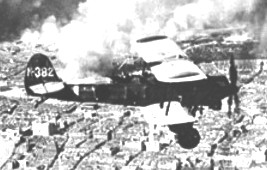
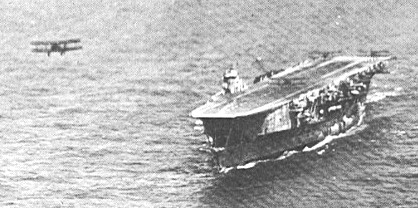 A KAGA B3YI attack bomber over Shanghai and an aircraft landing on KAGA
A KAGA B3YI attack bomber over Shanghai and an aircraft landing on KAGA
17 August 1937:
KAGA launches another raid on Suchow's air bases. One of her A2N3 Type 90 bi-plane fighters is damaged during the raid, but manages to return to the ship and s repaired. That same day, CHOGEI arrives from Port Arthur and disembarks troops at Shanghai.
SW of Hangchow, near Chiao-shih. A CAF Curtiss A-12 “Shrike” attacks three D1A2 dive-bombers and damages the engine of one. It stops, but restarts only about 500 feet from the ground. The pilot manages to land back on KAGA, but his gunner dies of his wounds.
18 August 1937:
Peiping. In a military parade, MajGen Kawabe Masakazu enters Peiping. His troops post proclamations announcing Kawabe is the city's new military governor.
20 August 1937:
BatDiv 3's HARUNA and KIRISHIMA depart Atsuta, near Nagoya, in company of light cruiser ISUZU. Both battleships carry three battalions (about 2,000 men) of the 3rd Infantry Division as reinforcements for the troops in Shanghai.
That same day, NW of Shanghai, a CAF 24th PS "Hawk III" claims an IJN A4N Type 90 fighter and a Nakajima E8N float reconnaiance planeover the Yangtze River.
21 August 1937:
BatDiv 1's NAGATO departs Komatsushima, Shikoku, for Shanghai. She carrys the 1st and 2nd Battalions (1,749 men) of the 43rd Infantry Regiment, 11th Infantry Division. BatDiv 1's MUTSU departs Mitohama for Shanghai carrying two battalions (1,948 men) of the 22nd Infantry Regiment.
Nanjing (Nanking). That same day, the Republic of China and the Soviet Union sign the Sino-Soviet Nonaggression Pact After the signing the pact, the USSR begins sending aircraft, including Polikarpov I-15bis fighters and I-16 "Rata" fighters to Chiang Kai-Shek's Chinese KMT Nationalists as well as economic aid to help stave off Japanese occupation.
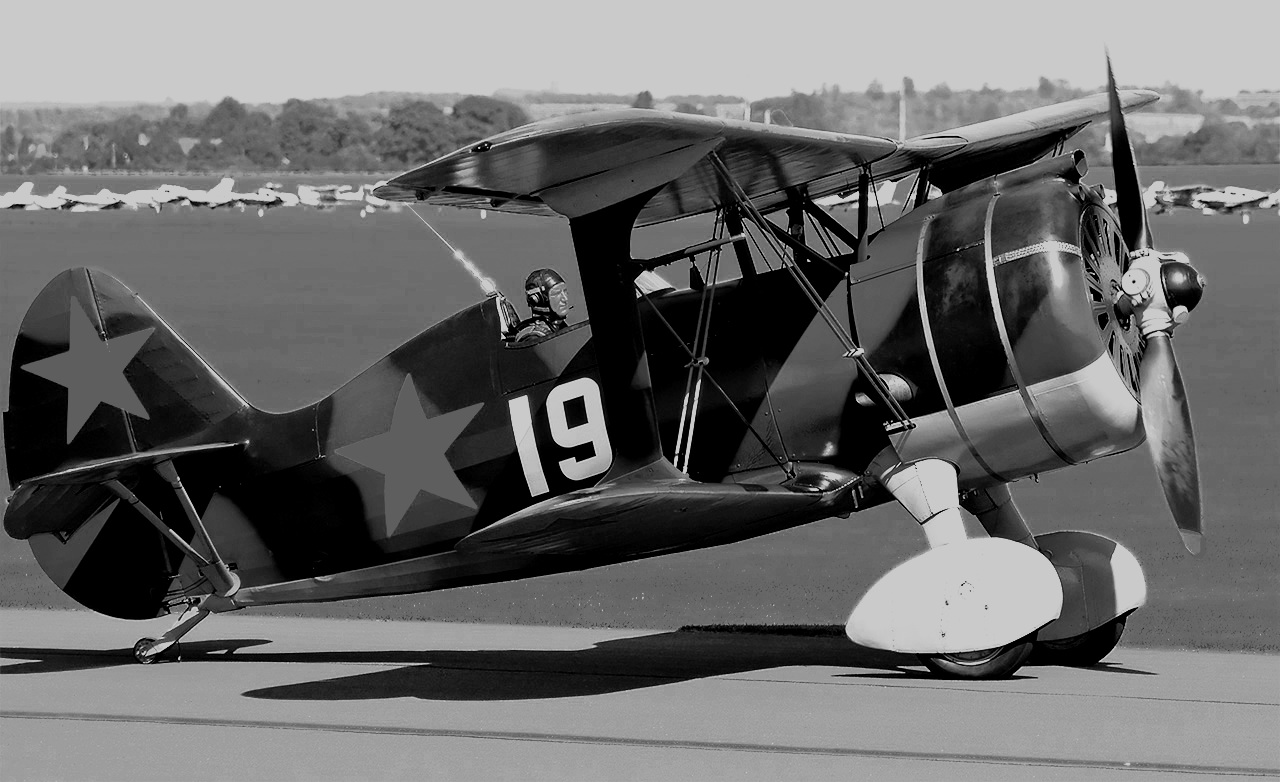
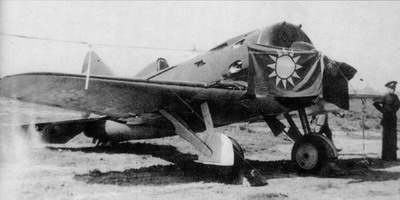 I-15bis (in Soviet markings) and I-16
I-15bis (in Soviet markings) and I-16
East China Sea. SubDivs 7 and 8's I-1, I-2, I-3, I-4, I-5 and I-6 provide distant cover against possible attacks from the west for BatDiv 1's NAGATO, MUTSU, BatDiv 3's HARUNA and KIRISHIMA and light cruiser ISUZU ferrying troops from Tadotsu, Shikoku, to the Shanghai area.
22 August 1937:
Nearing Shanghai, BatDiv 3’s floatplanes twice attack Chinese artillery batteries at Pootung (Pudong). Their secondary target is the Kiangnan Dock and Engineering Works, then the main Chinese shipyard. Floatplanes from BatDiv 1's NAGATO and MUTSU also bomb Chinese military installations in Pootung area, including an artillery battery, the Yining bridge and troops at Dachang.
BatDiv 3 also launches two floatplane strikes against targets in Shanghai area.
That afternoon, RYUJO launches her first sortie against Pao-shan (Baoshan). Four of her fighters bounce 18 Chinese Air Force (CAF) US-built CAF Curtiss "Hawk III" bi-plane fighters. In the surprise attack from the rear, six of the "Hawks" are shot down, with no damage to the attackers.
That same day, off the Saddle Islands, Japanese troops are transferred from the battleships to DesRons 1 and 2’s destroyers to ferry them upriver. In seven hours, troops from NAGATO are transferred to light cruisers OI and TAMA and destroyers KAWAKAZE, UMIKAZE, YAMAKAZE (DesDiv 24) and ARIAKE. In five hours, troops from MUTSU are transferred to light cruiser SENDAI, minelayer YAEYAMA and DesDiv 2’s YUDACHI, SAMIDARE, MURASAME, DesDiv 9’s SHIGURE, SHIRATSUYU and YUGURE. At 2130 (local), SENDAI is the last ship to leave the anchorage.
Off the Saddle Islands, BatDiv 3's HARUNA and KIRISHIMA transfer three battalions of the 3rd Infantry Division to DesRons 1 and 2's destroyers.
That night, the IJN launches an amphibious operation to relieve Shanghai's garrison and establish a beachhead. Later, they build within Kunda airfield at that location.
23 August 1937:
50 km NE of Shanghai. The IJN lands General Matsui Iwane's 3rd and 11th Divisions at Chuanshakou, Shizilin, and Baoshan under cover of Cdr/Prince Fushimi Hiroyoshi's DesDiv 6's guns. The IJN also makes other large-scale landings of Matsui's troops at Liuhe, Wusoong and Chuanshakou.
BatDiv 3 arrives off Shanghai. BatDivs 1 and 3 launch four floatplanes (mostly E8N1s) to reconnoiter Minhang, Songjiang, Jiading and Dachang. Among their targets is the Zhenru airfield where CAF "Hawk III" bi-plane fighters were sighted earlier.
At noon, over the Wan Chao Bin area of Shanghai, five CAF "Hawk IIIs" of the 21st PS supporting Chinese ground forces are engaged by about nine IJN aircraft. IJN fighters shoot down two "Hawk IIIs."
Over Pao-shan, four of RYUJO's fighters engage a mixed force of 27 of the CAF 17th Squadon's aircraft including Boeing Model 248 (USAAF P-26) "Peashooter" fighters. Nine CAF aircraft are shot down.
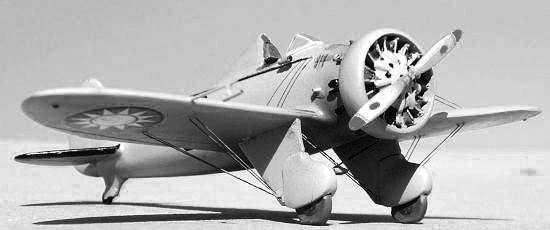 (CAF Boeing Model 248 [P-26] )
(CAF Boeing Model 248 [P-26] )
That same day, the Japanese bring in two IJA divisions, several cruisers, destroyer IJN AMAGIRI and other destroyers that increases IJN strength in Shanghai waters to 30 warships. At 0900, more than 10,000 Japanese troops enter Shanghai's suburbs. Fighting begins in the Zhabei, Wusong and Jiangwan districts. Gunboat IJN KOTAKA and the 11th Gunboat Division put ashore Special Naval Landing Force (SNLF) reinforcements. At 1600, warships of Vice Admiral (later Admiral) Hasegawa Kiyoshi’s (31)(former CO of NAGATO) 3rd Fleet in the Whangpu and Yangtze Rivers begin bombarding Chinese shore positions.
25 August 1937:
Over Shanghai, three Nakajima A2N Type 90 bi-plane fighters from IJN HOSHO engage three CAF U.S.-built Martin bombers and claim one bomber shot down. That same day, three German-built Heinkel He-111As of the CAF's 19th BS (Heavy) and five Martin B-10s of the 10th and 30th Squadrons escorted by seven Boeing fighters of the 17th squadron attack about 30 Japanese ships including IZUMO anchored in the Whangpu River in the area of Shizilin and Yuncaobin. Two He-111As are shot down. Also that day, the IJN fleet moored in the Yangtze is bombed by U.S.-built Curtiss A-12 "Shrikes" of the CAF 9th Air Group, but two A-12s are lost.
 (Curtiss A-12 "Shrike" in U.S. Army markings)
(Curtiss A-12 "Shrike" in U.S. Army markings)
Sixteen miles downstream, where the Whangpu joins the Yangtze, lay the mass of the Japanese fleet of over 50 warships. Most slowly steam back and forth to avoid almost constant sniping from the Chinese on shore. At times, there are up to 20 IJN warships in the Whangpu from which swarms of planes are launched and retrieved. The warships swing their heavy guns to shell one section of Shanghai, then another, and ferry sailors and SNLF troops ashore.
A major engagement ensues with approximately 100,000 Chinese and 60,000 Japanese troops involved. The IJN fleet of 50 vessels swells to 82, not counting scores of transports arriving almost hourly at the mouth of the Yangtze.
August 1937:
Shanghai. One-armed French Jesuit, Father Robert Jacquinot de Besange, convinces Japanese and Chinese military leaders to keep the Nantao area, an old native city next the International Settlement, free of fighting. Later, the area, called the Jacquinot Zone, shelters some 250,000 refugee Chinese.
26-27 August 1937:
After a brief detour back to Sasebo, KAGA returns to the area off Shanghai. Her air group bombs Nanking and attacks Chinese shipping on the Yangtze River.
Late August 1937:
Tokyo. Emperor Hirohito approves his military high command’s plans to send Japan's entire regular army ship--some 260,000 men -- across the sea to China launching Japan on a great national adventure. The Japanese appoints General Iwane Matsui to supreme command of the combined army and navy forces. Generalissimo Chiang Kai-shek appoints General Pai Tsung-hsi over some 300,000 Chinese forces in the Shanghai area.
Japanese troop ships with 55,000 men aboard steam to the mouth of the Yangtze. Some 13,000 land at various points near Woosung at the junction of the Whangpu and Yangtze north of Shanghai; the rest, 42,000, stay aboard waiting for an all-clear signal, while IJN warships demonstrate along the shore.
NW of Shanghai. After effecting landings on the banks of the Yangtze, the Japanese push southward on a broad front trying to catch the Chinese army in a pincers, of which their forces in Shanghai are the other prong. General Pai Tsung-hsi promptly begins to retire to the west, covering the railroad to Nanking.
The Japanese declare a blockade of the Chinese coast from Shanghai almost to Hong Kong. They announce the blockade is aimed only at Chinese shipping, but a few days later, Japan threatens that if American, British and other foreign ships call at Chinese ports, they also will be searched for contraband. British freighter SHENGKING, en route to evacuate refugees from Shanghai, is questioned by an IJN warship before being allowed up the Whangpu. Despite this, neither London nor Washington takes action. The blockade not only cuts off Chinese supplies, but reduces the collection of customs revenue for the Chinese.
1 September 1937:
HOSHO flies her first strike against Shanghai, then departs and returns to Sasebo for refueling.
2 September 1937:
RYUJO returns to Sasebo for refueling.
3 September 1937:
The IJA 5th Tank Battalion is landed at Wusong.
5 September 1937:
CarDiv 1's HOSHO and RYUJO depart Sasebo.
9 September 1937:
Mobilization orders are issued for the IJA 9th, 13th and 101st divisions and the Taiwan Garrison Brigade.
15 September 1937:
Italian light cruiser RAIMONDO MONTECUCCOLI arrives at Shanghai from Tientsin. At least 1,200 Italian Army and Navy troops are in China to defend the safety and interests of 500 to 600 resident Italians.
19 September 1937:
Shanghai. Transport USS CHAUMONT (AP-5) arrives off the Bund with the 6th Regiment, United States Marine Corps to reinforce the 4th Marine Regiment in guarding the American sector of the International Settlement. Later, CHAUMONT and MONTECUCCOLI are involved in a collison.
 (USMC machine-gunner guarding American sector of the International Settlement)
(USMC machine-gunner guarding American sector of the International Settlement)
21 September 1937:
HOSHO and RYUJO begin air strikes against Chinese bases in the area of Canton (Kwangtung, now Guangdong). In the morning, despite bad weather, 15 carrier fighters, including six from HOSHO, escort 12 carrier bombers and three carrier atttack planes in an attack on the Teinho and Peiyun airfunds. They are engaged by CAF Curtiss "Hawk" bi-plane fighters and many are shot down, including six claimed by HOSHO's pilots and another six by RYUJO's pilots. Five of HOSHO's fighters run out of fuel and ditch. All their pilots are rescued by IJN vessels.
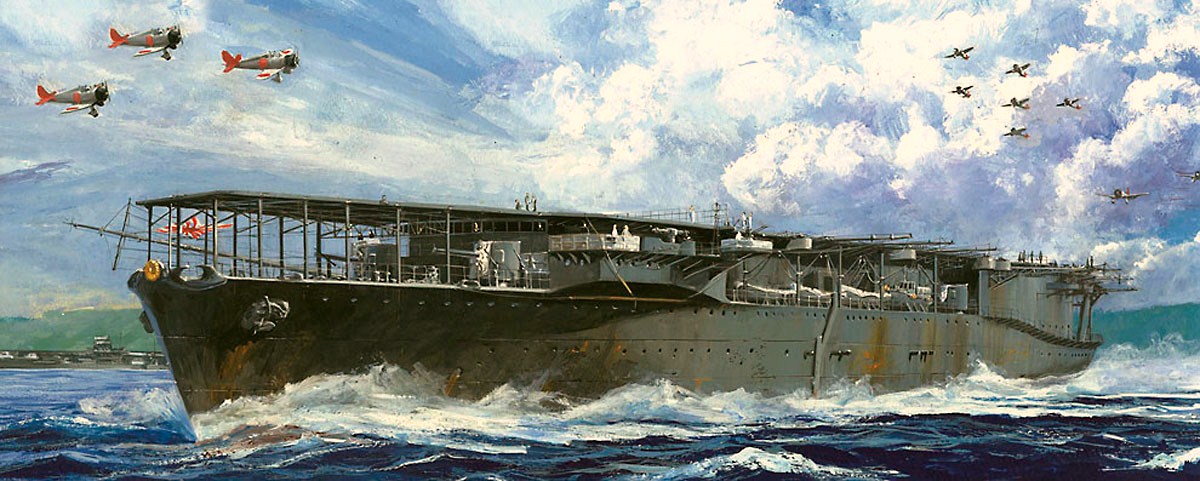 (IJN HOSHO by Ueda Kihachiro)
(IJN HOSHO by Ueda Kihachiro)
That afternoon, RYUJO launches six carrier bombers, three carrier atttack panes and nine carrier fighters to attack Guangdong. They are engaged by CAF Curtiss "Hawk" bi-plane fighters. RYUJO's pilots claim five "Hawks" shot down.
21-30 September 1937:
HOSHO and RYUJO's air strikes continue almost daily, but there are few air combat engagements.
22-23 September 1937:
Koin. Chinese light cruiser NING HAI is attacked several times by aircraft from KAGA operating from Hangchou Bay south of Shanghai, and the ground-based 2nd Combined Air Flotilla. She sustains hits by four bombs and several near misses. Light cruiser PING HAI is also attacked and sustains hits by eight bombs and several near misses. Her captain is badly wounded, but continues the fight. PING HAI settles in shallow water near Koin. The Chinese shoot down several IJN aircraft and damage others. [3]
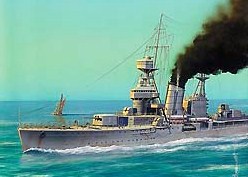 (Chinese cruiser NING HAI)
(Chinese cruiser NING HAI)
25 September 1937:
Six Yokusuka B3YI attack bombers of the 2nd Combined Air Flotilla score two direct hits on NING HAI. She sinks in shallow water upstream of Koin. [4][5]
3 October 1937:
HOSHO and RYUJO arrive off Shanghai. Their aircraft are deployed to Kunda airfield in Shanghai for support of ground operations in the Shanghai and Nanking area. Later, HOSHO transfers her aircraft to RYUJO.
17 October 1937:
HOSHO arrives at Sasebo.
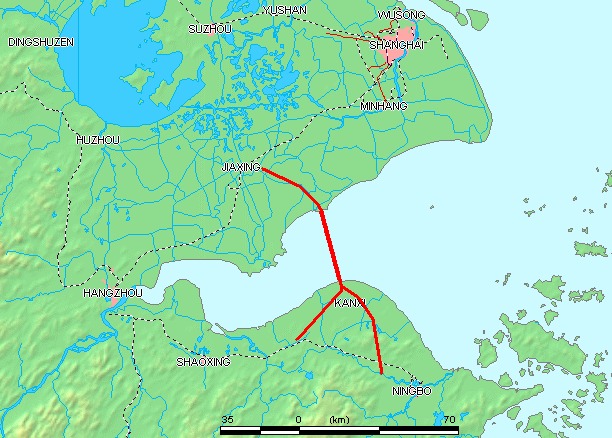 (Hangzhou Bay and the Zhoushan Islands - bridge post WW2)
(Hangzhou Bay and the Zhoushan Islands - bridge post WW2)
10 November 1937: - The invasion of Hangzhou Bay:
Hangzhou Bay, an inlet of the East China Sea, lies south of Shanghai and ends at the city of Hangzhou. The bay contains many small islands called the Zhoushan Islands.40 transports escorted by five destroyers land LtGen Suematsu Shigeharu’s 114th Division at Hangzhou Bay.
The 1st Squad of the invasion convoy that departed Osaka on 30 October is led by destroyer YUZUKI and consists of transports ALASKA, BUZEN, ENGLAND, GYOKO, HAKODATE, INDUS, KAISHO, KOSHIN, MINAMOTO, SANDAI. SHINTAN, SHOKYU, SHUNSEI, SUEZ, TOKUSHIMA and ZENOAH MARUs.
The 2nd Squad is led by destroyer MIKAZUKI and consists of transports BEIJING, FUSHIMI, HORAI, JUYO, KARAFUTO, KURETAKE, MEIKO, SHINYO, SHIN YUBARI, SHINSEI, TAIAN and YAMATO MARUs.
The 3rd Squad led by destroyer MOCHIZUKI and consists of transports DAIMON, ETO, FUKUSHO HAKUSHIKA, KANKO, MALACCA, NAVEL, OIRDONO, SHIN-AI, SHUKI and TASMANIA MARUs and YOSHIDA MARU No. 1.
20 November 1937:
Imperial Palace, Tokyo. Japanese Imperial Headquarters, superior to the IJA and IJN General Staffs, is opened on the palace grounds. Emperor Hirohito (Showa) takes personal charge of the war. He remains in this capacity until 15 Aug '45.
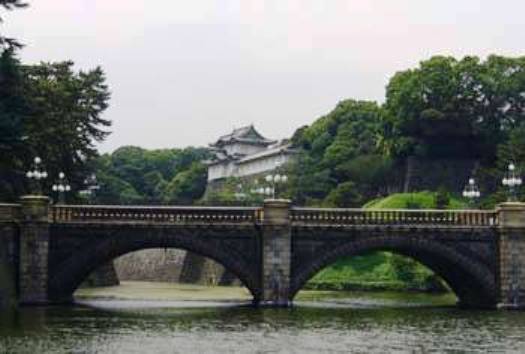 (Imperial Palace)
(Imperial Palace)
November 1937:
Colonel (later MajGen) Eugen Ott, Military Attache at the German Embassy in Tokyo, arrives at Shanghai to explain to the Japanese why Adolf Hitler has not pulled German military advisers out from assisting the Chinese. Ott explains that the previous German Republic gave up their extraterritorial rights in China in WW1. Therefore, present-day Nazis are concerned that the Chinese could turn on resident German nationals, whereas the Americans, British, French and Japanese citizens in China are protected by their countries' treaty's rights.
5 November 1937: Fall of Shanghai:
Zhoushan archipelago's Hangzhou Bay, 50 miles SW of Shanghai. Thirty-nine IJN destroyers and shallow draft gunboats bombard the Shanghai peninsula's southern coast. Captain-Retired (later Rear Admiral) Katahara Tsunejiro’s (37) seaplane tender KINUGASA MARU participates in a successful landing of the IJA's 10th Army, under cover of thick fog, behind Chinese lines on the northern shore of the Hankow estuary in Jinshanwei. IJA SHINSHU MARU also participates in the nearly unopposed landing. Chinese forces withdraw to the west. The landing enables the Japanese to advance to within 15 miles of Shanghai from the south. The Chinese begin to evacuate the whole Shanghai peninsula and the Japanese enter sectors without resistance which for three months have been bitterly contested.
8 November 1937:
Generalissimo Chiang Kai-shek issues an order for a general retreat.
12 November 1937:
Shanghai is cleared of Chinese troops. Nearly a quarter million Chinese including women and children are killed. while the Japanese suffer 10,076 KIA and 31,866 men WIA. After 92 days of fighting, the Japanese capture one of the largest ports in the world.
26 November 1937:
The Chinese Army fall backs to the capital of Nanking (Nanjing).
Authors' Notes:
During the first Sino-Japanese War of 1894–95, China, then under the Qing Dynasty, was defeated and forced to cede Formosa (Taiwan) to Japan and recognize the independence of Korea in the Treaty of Shimonoseki.
[1] Peiping was also known as Peking.
[2] A separate "Rising Storm" segment on "The Occupation of Tientsin's (Tianjin) British and American Concessions - 1940-1941" will be posted in due course.
[3] Later, the Japanese raise NING HAI, tow her to Shanghai and then to Sasebo where she is repaired and reclassified as coastal defense and training vessel IJN MISHIMA. In '44, she is reconstructed, reclassified a kaibokan and renamed IJN YASOJIMA (also known as YASOSHIMA).
[4] The Japanese also raise PING HAI, tow her to Shanghai and then to Sasebo where she is repaired and reclassified as coastal defense and training vessel IJN MIKURA. In '44, she is reconstructed, reclassified a kaibokan and renamed IJN ISOJIMA (also known as ISOSHIMA).
[5] How the Chinese fleet fled the Shanghai area is covered in a separate segment on the "Destruction of the Chinese Fleet - 1937."
Thanks go to David Aiken of Hawaii and Rev. Sidnei Maneta of Sao Paulo, Brazil for additional IJN aircraft info in Rev 1. Thanks also go to John Whitman of Virginia and Fontessa-san of Japan for info about the invasion of Hangzhou Bay in Rev 3.
-Bob Hackett, Sander Kingsepp and Anthony Tully
Back to Rising
Storm Page
























